This midweek had some cup matches across Europe, so we picked the clash between Southampton and West Ham United on Wednesday night as the topic of this tactical analysis.
At the St Mary’s Stadium, Ralph Hasenhüttl’s team progressed with a 3-1 victory. Intriguingly, by the time the lineups were announced, almost everyone, from fans to pundits, believed David Moyes’ Hammers could walk away with a win easily given Southampton’s starting XI. Surprisingly, the hosts showed incredible courage throughout the game and booked the place in the next FA Cup round.
The game was not as easy as the scoreline suggested. In the beginning, West Ham gained the upper hand with tactics superior to the opponents, but the Saints adapted and played better as the game continued. This analysis will explain how Southampton gradually nullified the threat of the opponent in open plays.
Lineups
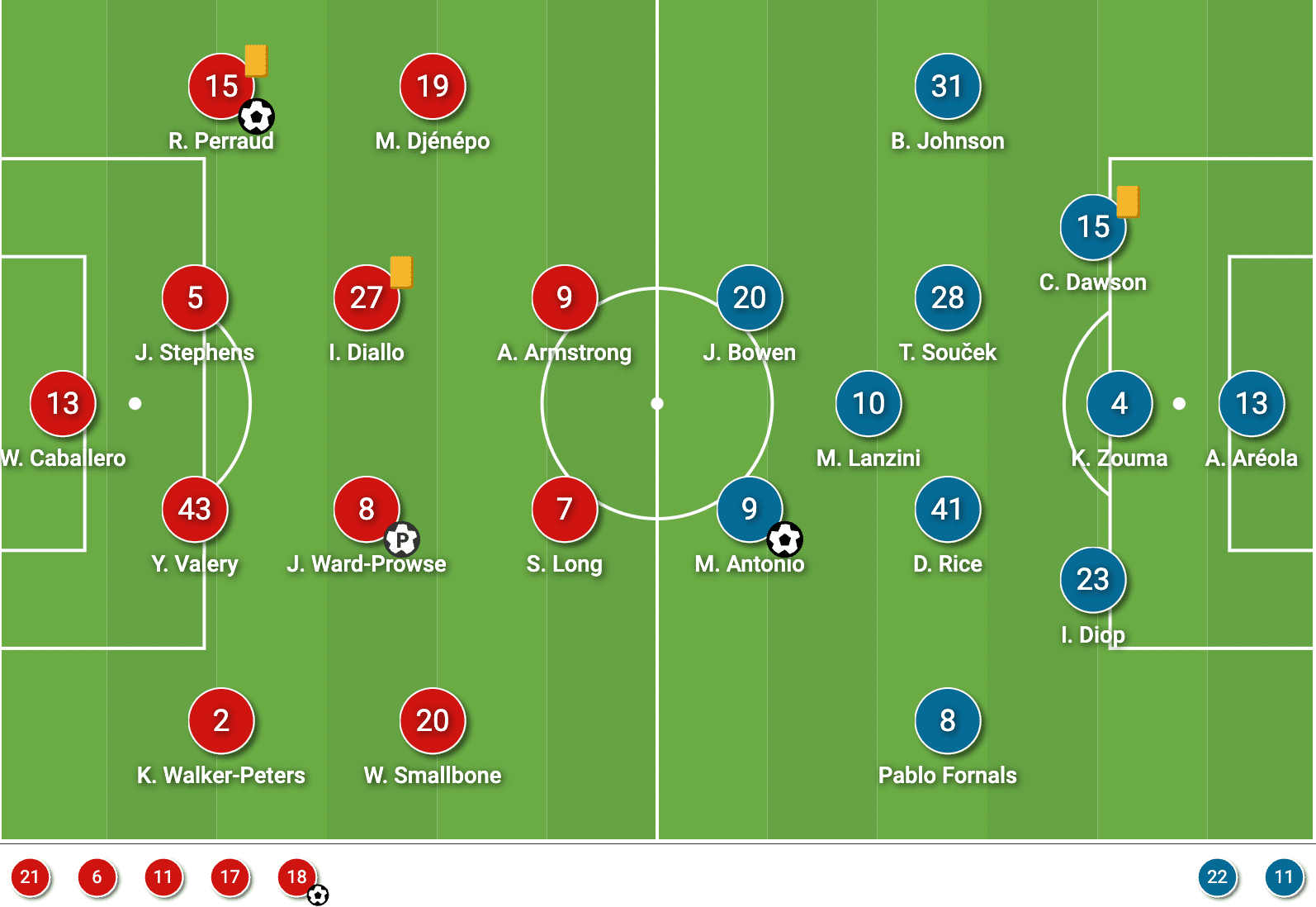
People were concerned about the Southampton lineup for good reasons, even Hasenhüttl himself admitted some players did not have the rhythm, so they needed this game to recharge the likes of Shane Long and Will Smallbone. There were a total of nine players rotated compared to the last Premier League game, only James Ward-Prowse and Kyle Walker-Peters started in the Norwich win.
West Ham, by contrast, came with a very strong squad that helped them challenge the top four in these two seasons. Moyes only made two changes, one of them was to start Alphonse Areola over Łukasz Fabiański, and the other one was replacing Aaron Cresswell with Issa Diop. The rest were starting in the Wolves win.
West Ham central overload
At the beginning of the game, West Ham were also the better side given they had a strong lineup. The Hammers were closer to scoring the first goal than the opponents, but they were unable to put the ball behind in the net despite some good final third entries and crossings.
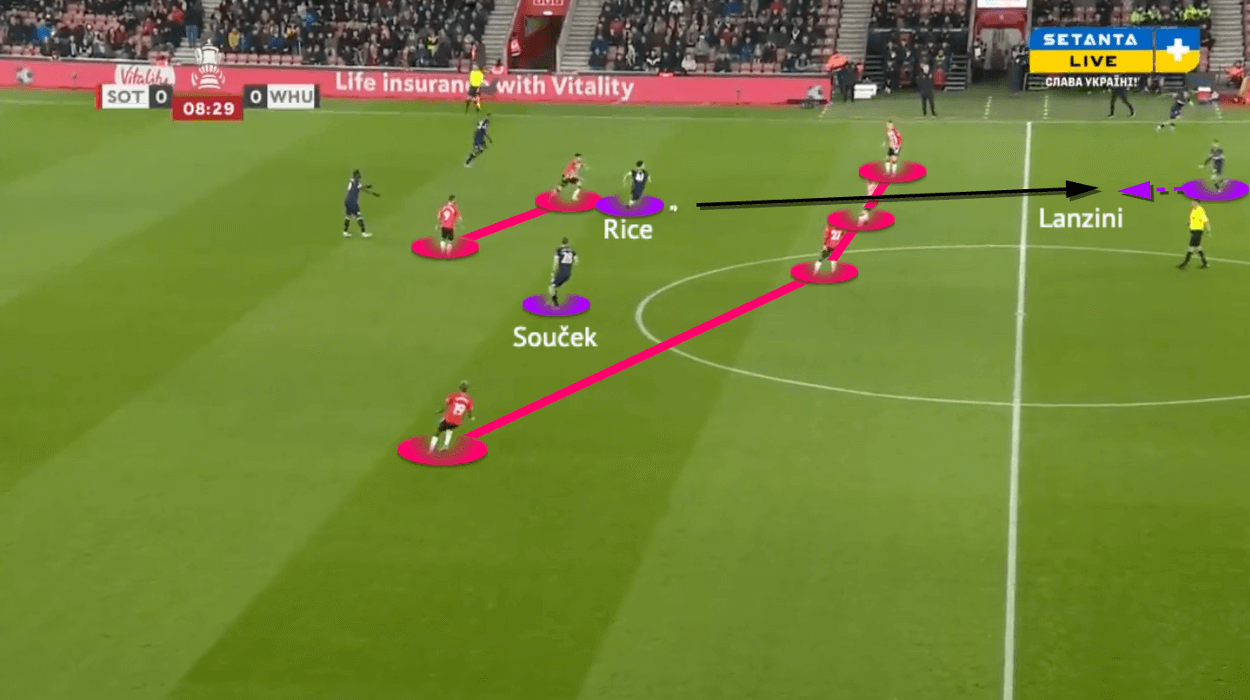
The main reason for West Ham’s good display was their midfield numerical superiority. They played with a 3-2-1-4 in possession, the formation naturally contained three midfielders, one more than Southampton’s 4-4-2. This “+1” advantage in the centre was the problem of Southampton as they struggled to shut Manuel Lanzini between the lines.
West Ham were very confident with two midfielders in front of the back three, Declan Rice and Tomáš Souček operated between Southampton’s first and second line, the deep positions of these two players always dragged the Southampton 6s out together simultaneously. Then, just one forward pass could break the line to reach Lanzini. As we drew above, the second line of Southampton was so flat and detached from the last line, that gave Lanzini so many spaces to turn.
Also, the Southampton left-winger, Moussa Djenepo, was often caught too high in the press. Since West Ham played with a back three, Djenepo oriented himself to Craig Dawson, but that means he might be away from teammates when the opponents were not attacking on Dawson’s side.
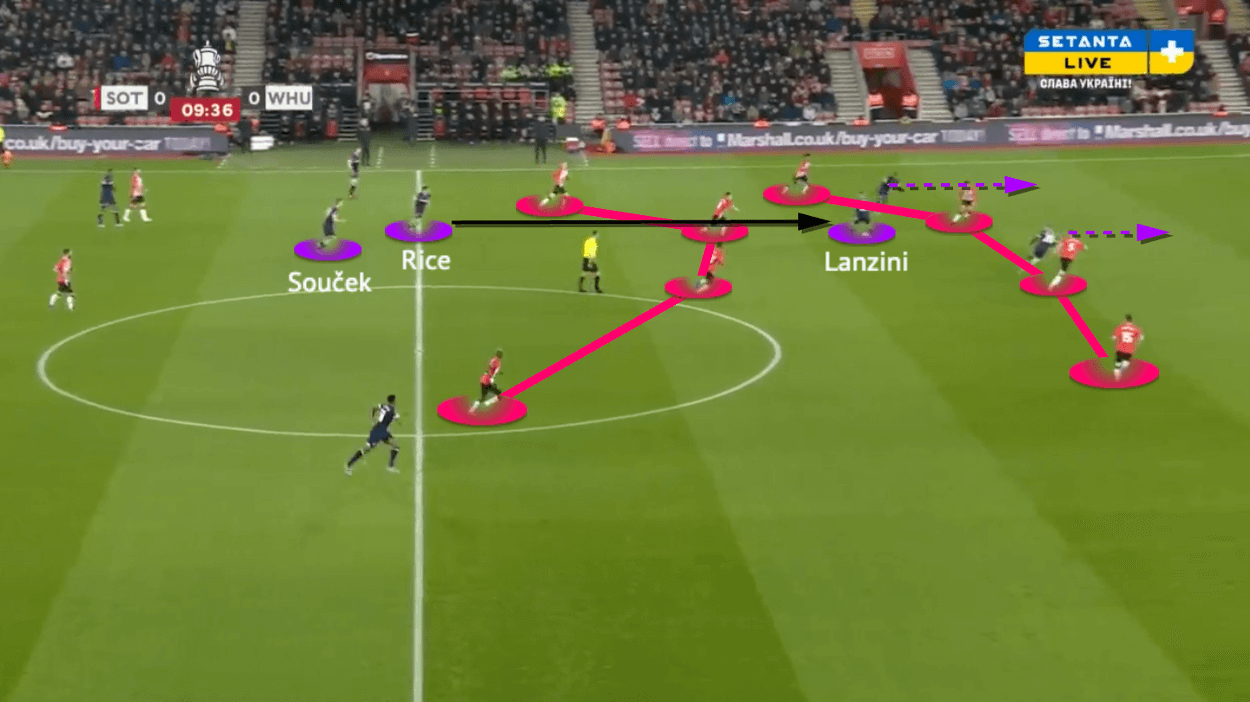
Since Southampton were more in a 4-4-2 shape than the 4-2-2-2 shape without wingers moving in as the 10s, the opponents broke them very easily. Again, in the above image, we saw their parallel midfielders without possession were being caught too high. When Rice and Souček were playing deep, both Ward-Prowse and Ibrahima Diallo stepped up, but they never access the West Ham midfielders. Hence, the defensive positionings were suboptimal as they conceded spaces between the lines for Lanzini to operate.
The Southampton centre-backs could not step up because the two West Ham strikers were staying tightly together in the centre. Both Jarrod Bowen and Michail Antonio possessed some pace to exploit spaces behind the last line, and they would run into the channels when Lanzini received, so Jack Stephens and Yan Valery must retreat to keep both runners on track as we had shown above.
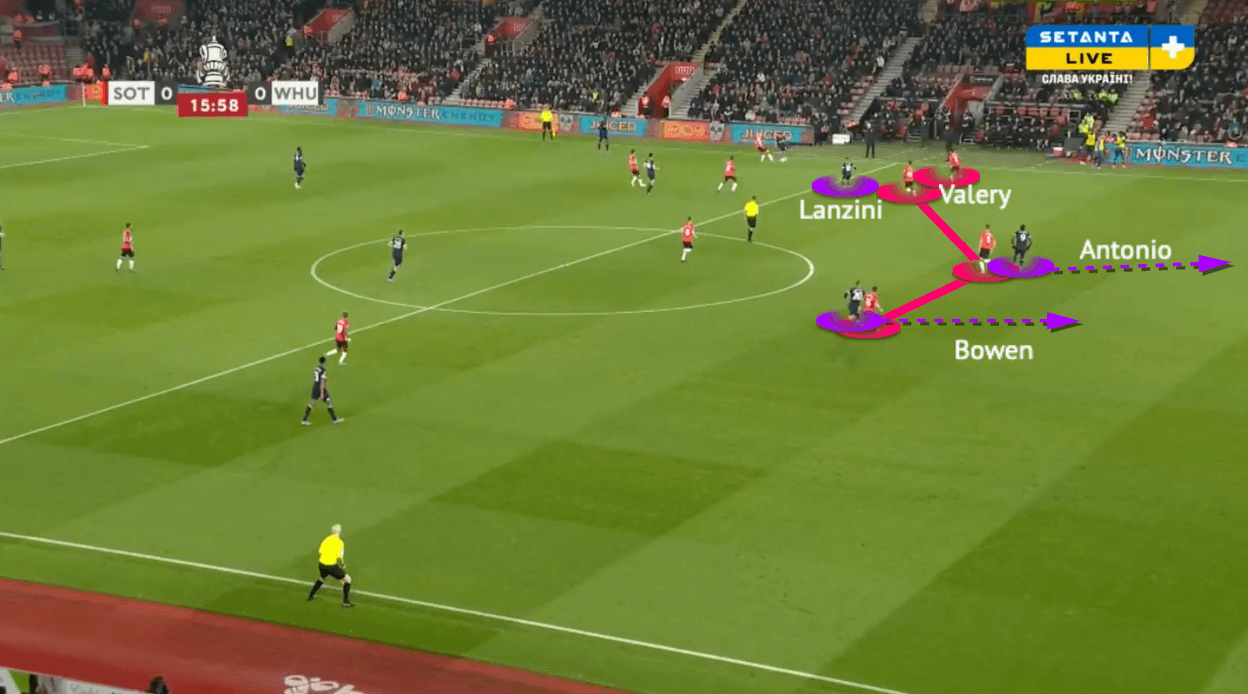
There was one occasion in which the centre-backs did not follow the strikers in two 1v1s. In the above image, West Ham attacked in the same way, the Southampton 6s were dragged too high, spaces behind the midfield were without protection. This time, it was different as Yan Valery stepped up to close Lanzini, but the opponent counter-acted by directly sending the ball behind him.
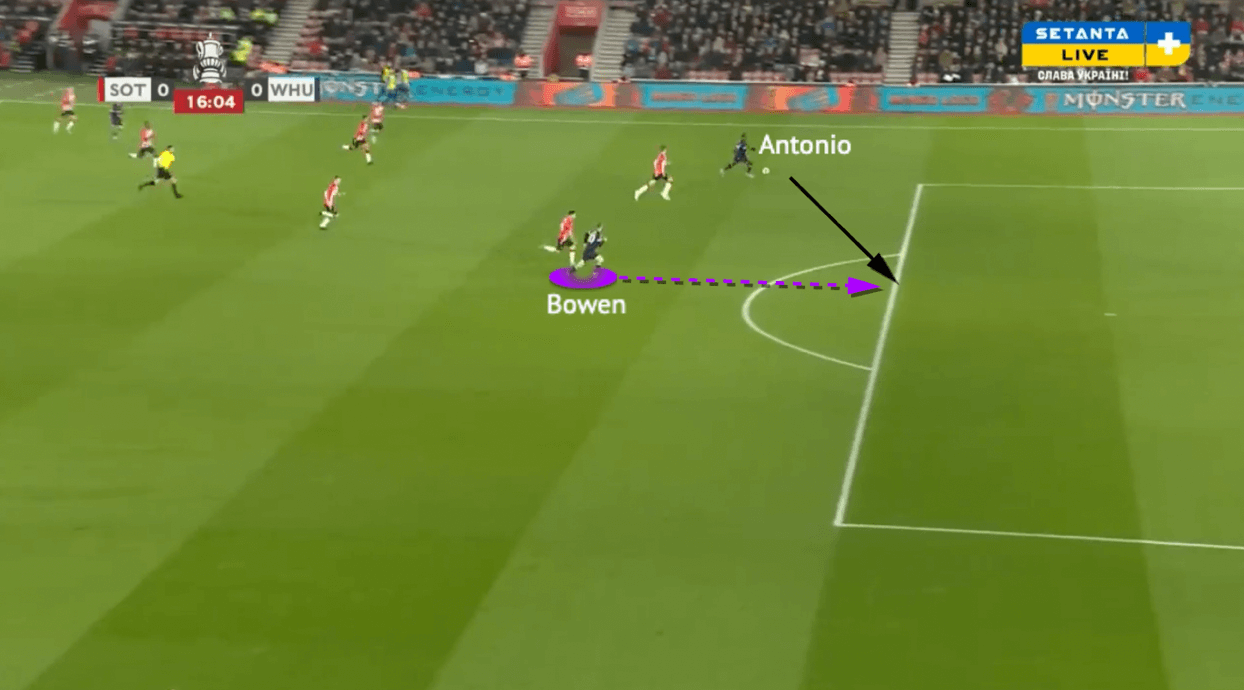
Southampton, as a result of Valery stepping up too early, they were caught, and this could potentially cost them a goal. Antonio outran Stephens to receive the ball, with Bowen also joining in the centre (he was past Romain Perraud already), if the cross was released sooner, that is a 1v1 against the keeper and the Hammers might have taken the lead.
In reality, Antonio was a bit off here and kept the ball for too long. He wanted to check the ball back to his stronger foot, but that slowed him down and the Saints defenders rushed back to close him down.
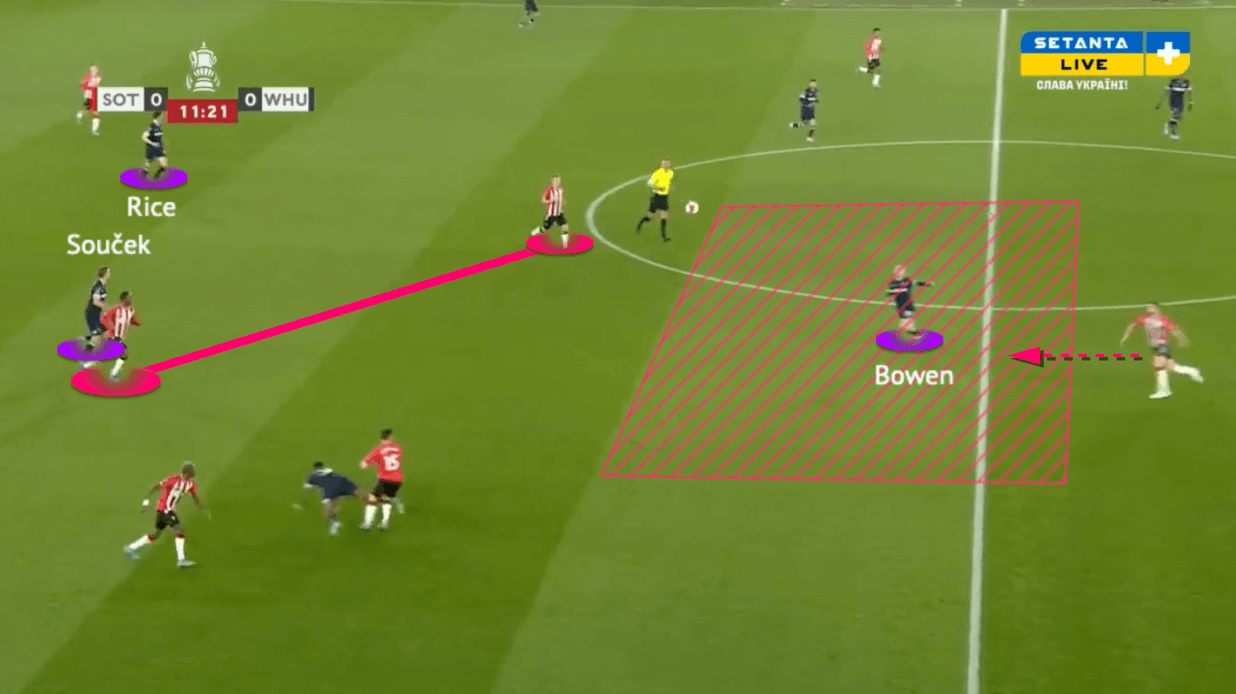
West Ham were very successful at dragging the opposition 6s out in the construction of the attack. Even they did not go to the midfield or Lanzini and being rather direct occasionally, the approach was still beneficial because it vacated spaces in the midfield.
Here, in the above screenshot, Souček and Rice were deep and both Diallo and Ward-Prowse were a bit high. When the Hammers played long, the second ball dropped in the midfield, the Southampton centre-back was exposed in a 1v1 situation against Bowen. The spaces were too open for a dropping ball and that gave the Hammers so many rooms to progress the attack.
Southampton adapted in the midfield
West Ham gained an upper hand with the midfield 3v2 dominance, but this situation did not last too long because Hasenhüttl’s side adapted to nullify the advantages of opponents.
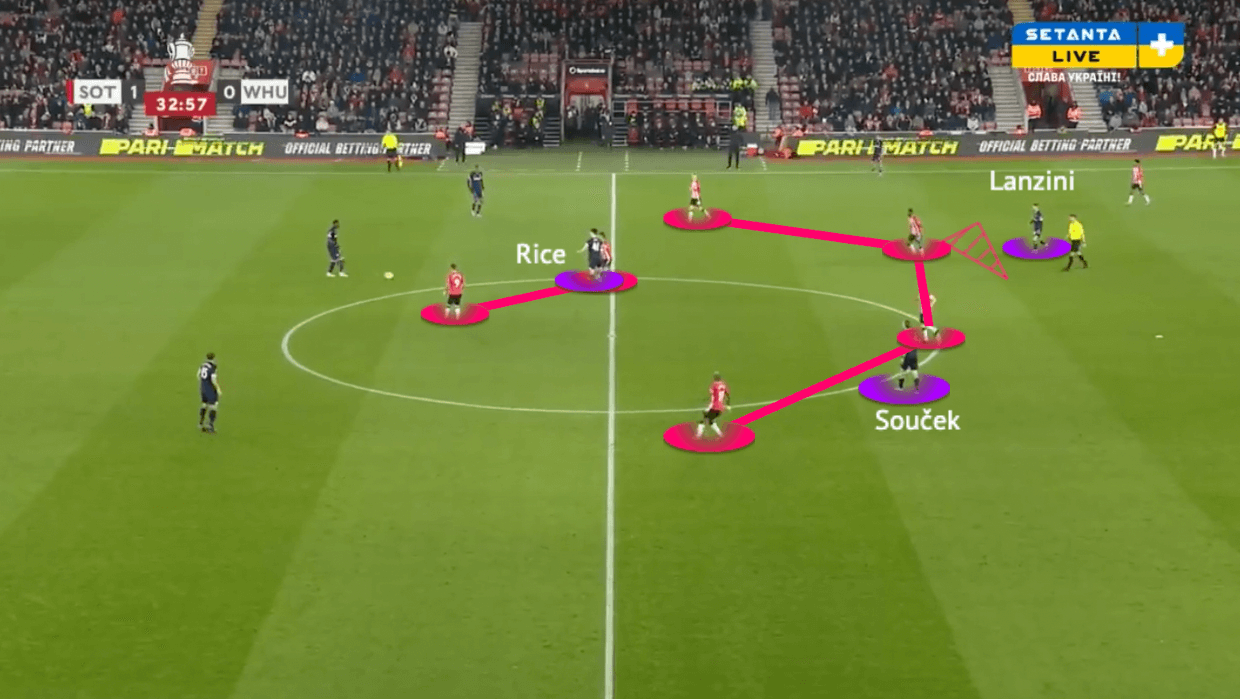
In the first half, Ward-Prowse and Diallo no longer stepping up together. They were sitting rather deeper to make sure Lanzini did not receive in spaces. The above image shows the strikers dropping into the central third to cover Rice, and Diallo kept Lanzini under his shadow, with Ward-Prowse closing Souček.
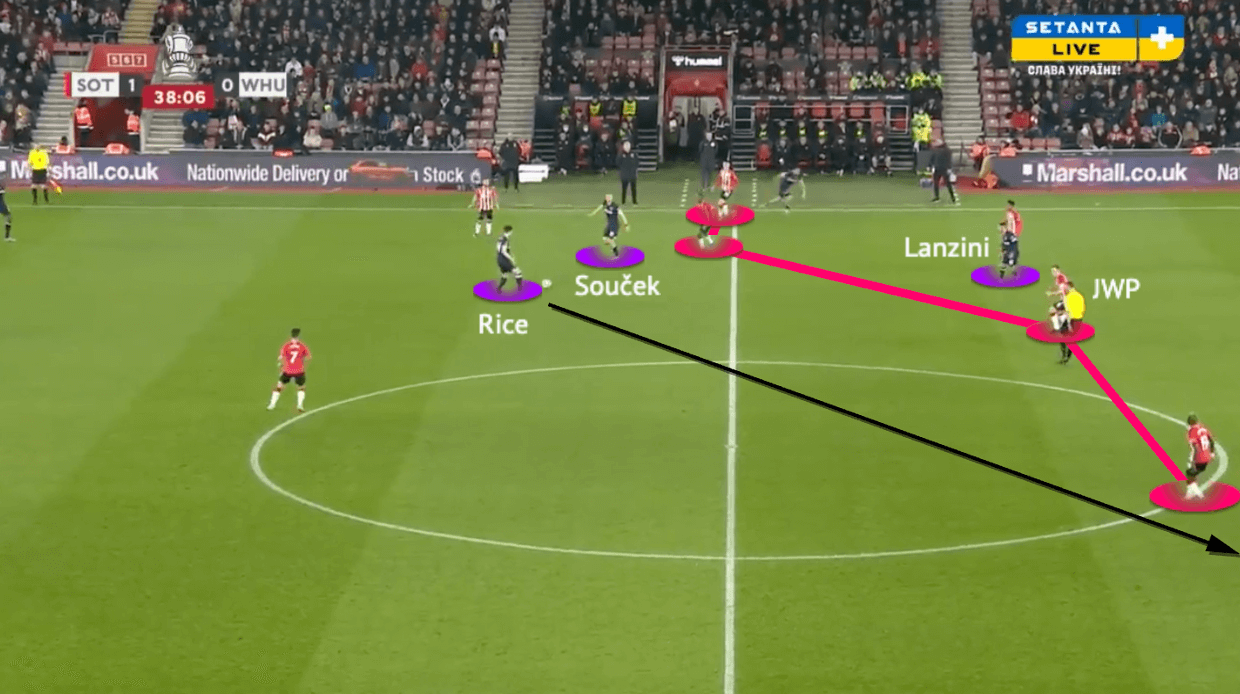
Even when the Southampton 6 stepped up to press, they would not do it together, only one of them would commit and the other one staying a bit deeper. This is the basic “pressing and cover” concept, if the second line was too flat without the ball, the opponents could break very easily with just one passes.
In the above image, when Diallo pressed Souček, Ward-Prowse stayed, with Walker-Peters a bit higher, they closed Lanzini between the lines. But without the strikers pressing in the midfield, West Ham still had an additional man as Rice would be free to pass, although the pass was no longer vertical inside the block. Instead, it was usually a diagonal switch to find Ben Johnson on the right side.
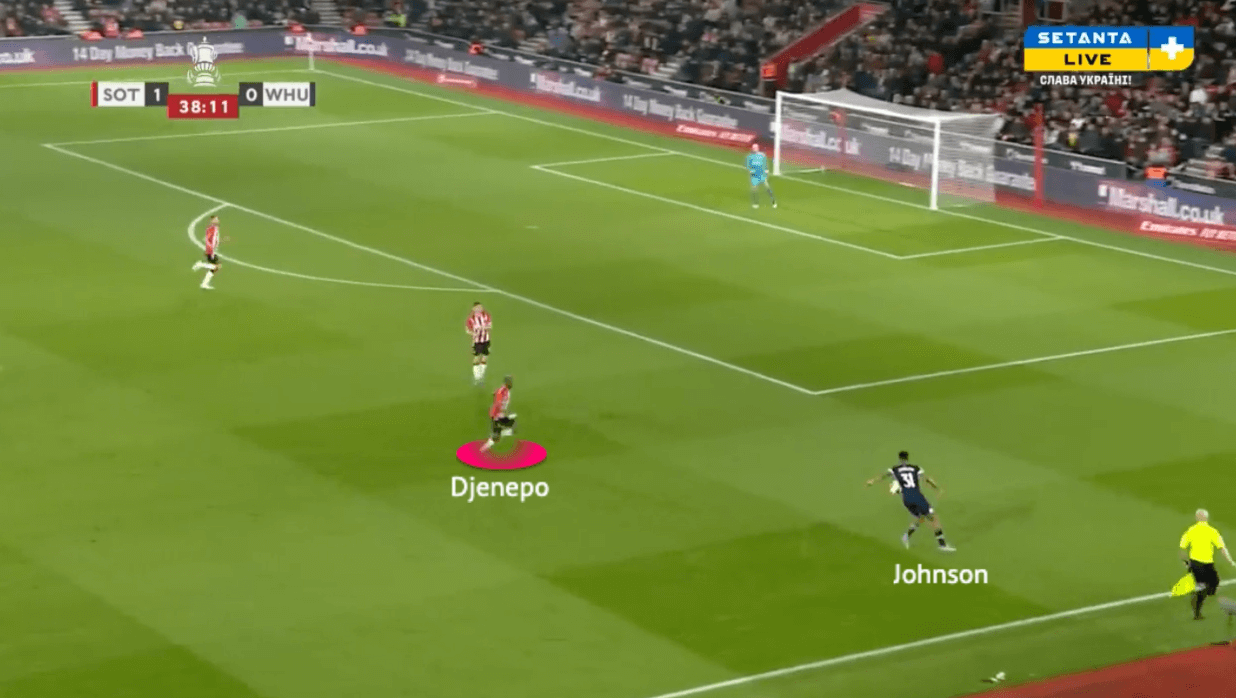
Even though the good passing from Rice always released Johnson in the final third, this was still better than letting Lanzini playing between the lines. If Johnson received in the wide zone, it was not an instant threat because the other West Ham players might not be arriving quickly, and there was time for the defenders to run back to close him down. In some cases, the left-winger, Djenepo even dropped so deep to cover the wide zone for Perraud as shown above, that allowed the Southampton back four to stay compact in the centre to defend the crosses.
By contrast, if Lanzini received between the lines, the final passes would be inside the block and through the centre. As pointed out in the previous examples, those situations could result in goal-scoring opportunities, so it was better to let West Ham go outside then playing in the centre.
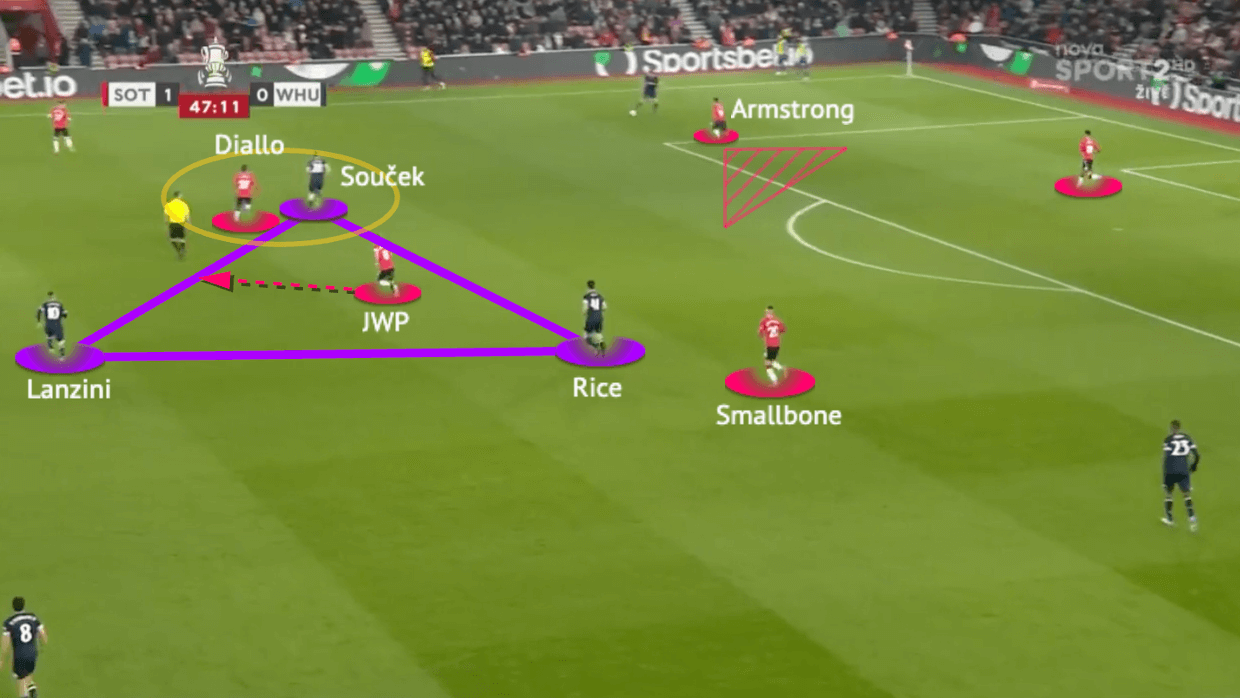
In the second half, the midfield pressing of Southampton was even better with the introduction of Stuart Armstrong and Armando Broja, they had better tactical awareness to close the West Ham 10 instead of matching the parallel midfielders in higher spaces.
The above image shows an alternative pressing, Southampton’s winger, especially on the left side, was deeper, Dawson no longer took the left-winger out as now the striker would press the centre-backs laterally. In the midfield, the Saints were more compact with the far side winger defending in the centre, as Smallbone closed Rice to make it a 3v3 in the midfield. This allowed Ward-Prowse to drop back and cover Lanzini when Diallo was tight on Souček. The Hammer could no longer play in the centre.
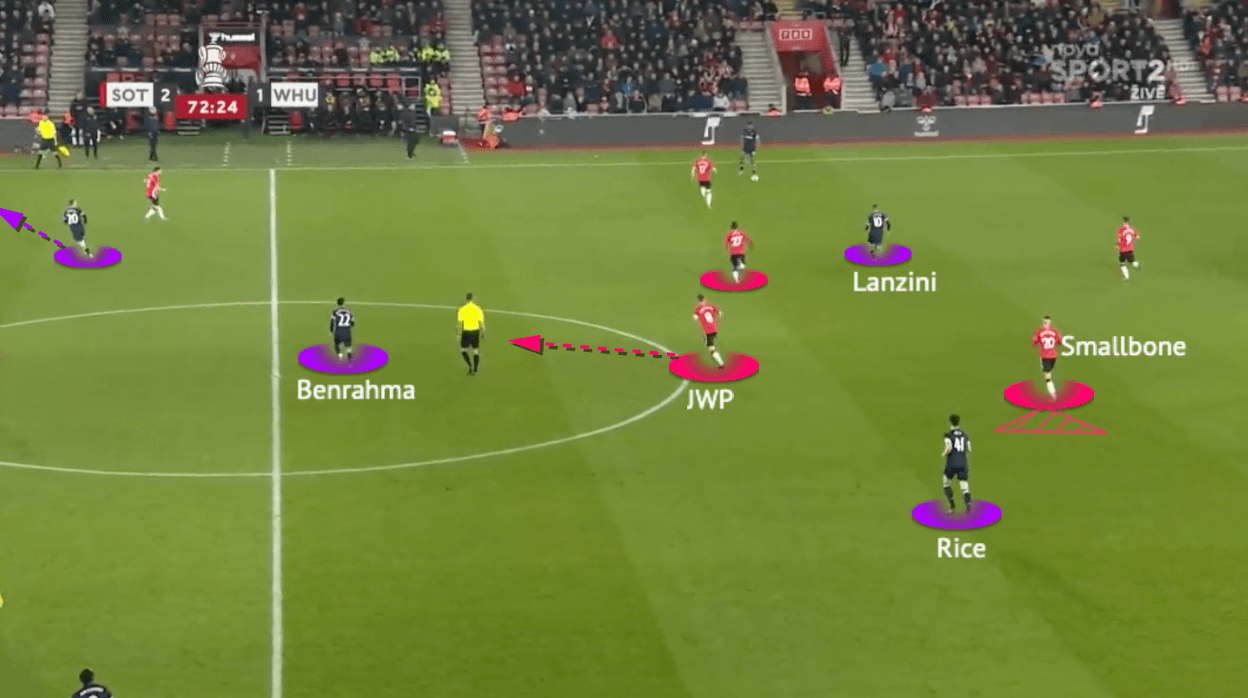
Moyes also made changes, replacing Souček, who was a bit out of form, by the Algerian international Saïd Benrahma, but the formation did not change, so tactically this was not solving the new pressing system of Southampton.
The above image shows Southampton’s structure. Even Bernahma came in as a 10, the Saints still had the midfield balance because Smallbone, the right-winger was defending in the centre. West Ham almost never played square passes to the far side 6, and they were without a free player on the ball side because Ward-Prowse was retreating to cover spaces behind when Diallo was close to Lanzini.
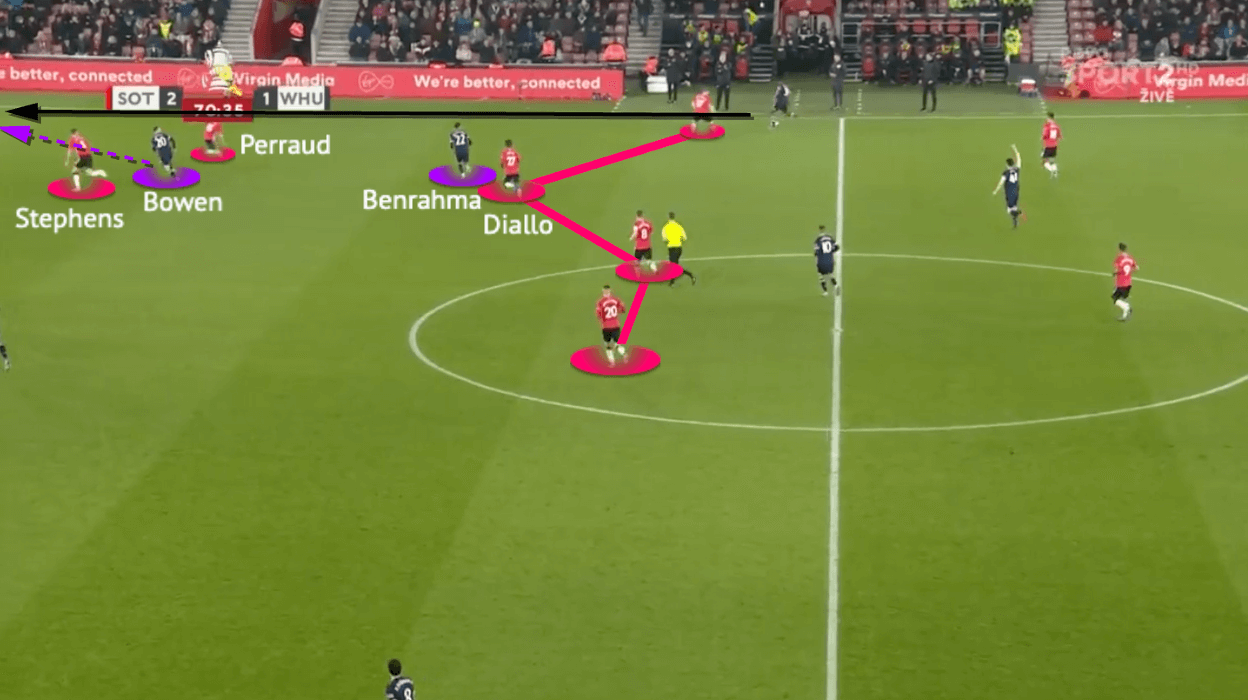
The above example shows another scene of Southampton defending, which the deeper 6 compressed spaces with the defenders. When Benrahma dropped, Perraud stayed tight, and because the midfield duo was not positioning themselves in the parallel zone, they closed spaces to make sure the receiver could not turn easily in spaces between the lines.
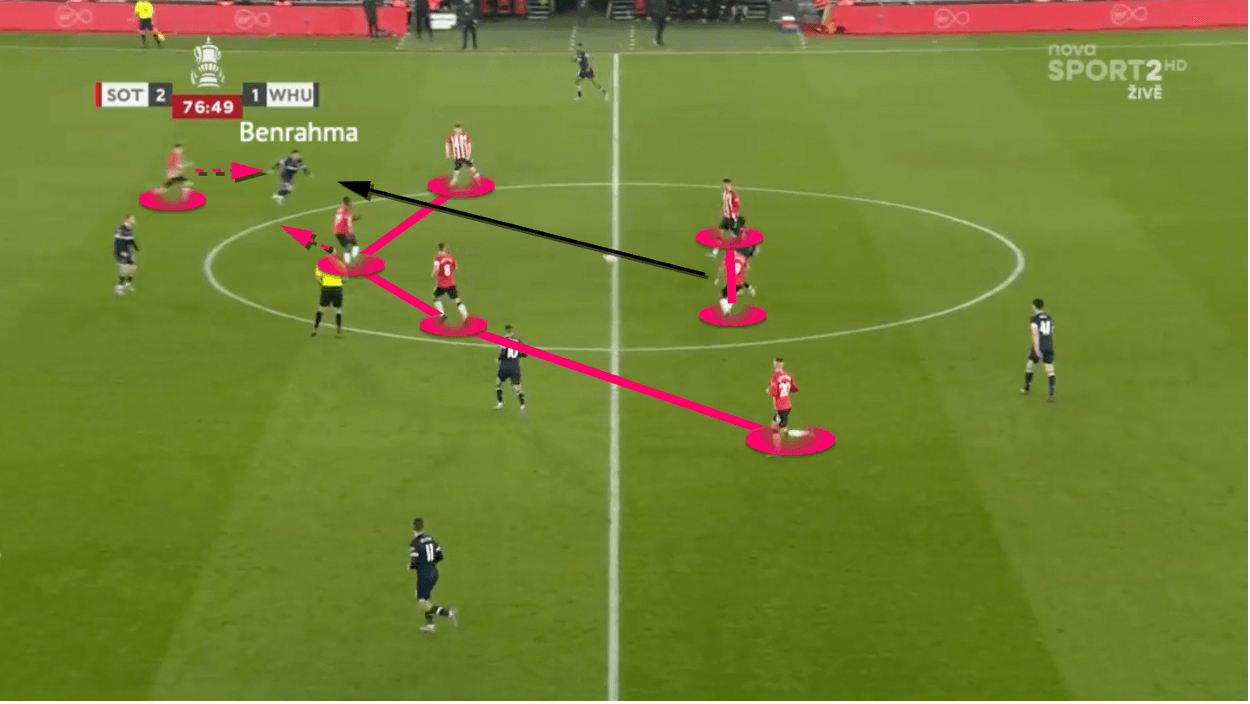
West Ham strikers were playing a bit differently in the second half, and sometimes it was a 4-1-4-1 shape as Bowen no longer played centrally. Instead, the former Hull City winger kept searching for attacking depth behind Perraud, because they knew the Southampton left-back could be caught impatient and too high. But that was not a great threat because the Hammers might be growing frustrated and exhausted as the game continued, and Bowen’s runs were well-covered by Stephens.
Meanwhile, as shown in the above image, the central option, Benrahma, was closed by Diallo, so West Ham were without too many options in the attack, the runs and forward passes to release Bowen were quite predictable to track.
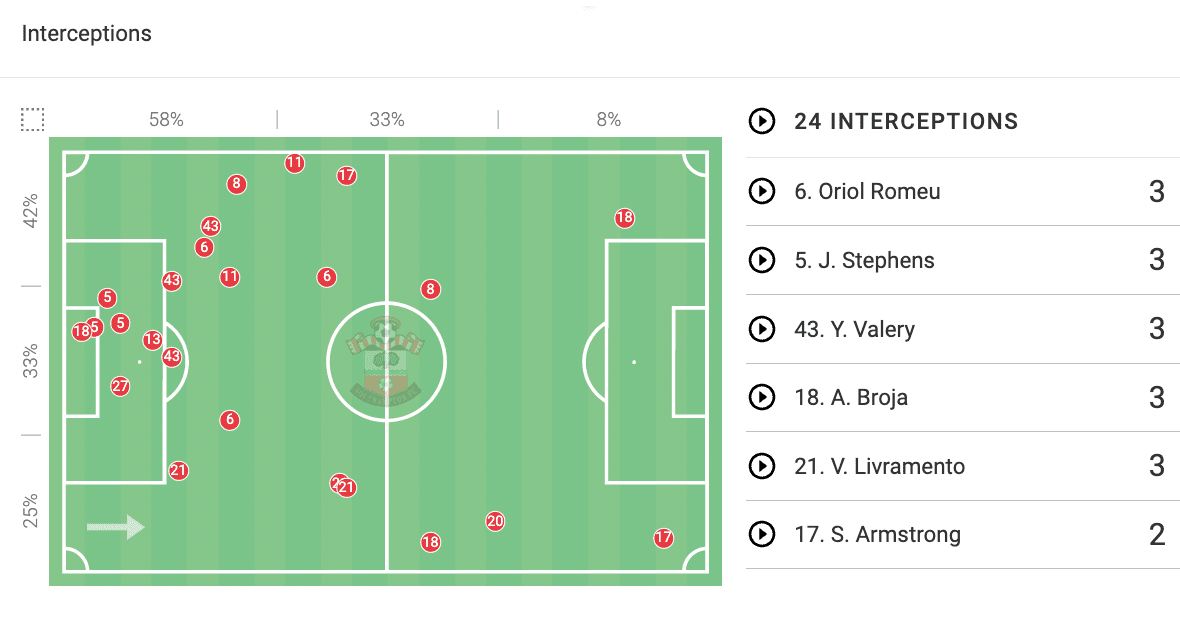
Southampton in possession
With the ball, Southampton were a bit cautious in the first half. They committed at least four players in the build-up plus Willy Caballero, so there were more men even the ball was lost in the middle third. They tended to play balls into the “red zone” instead of going behind, as Djenepo was a hybrid player who roamed between a left-winger and a 10 in half-spaces. He occupied spaces behind Souček to receive and turn, trying to release the runners but the Saints did not get everything right in the final third.
In the second half, S. Armstrong and Broja were introduced to the game, both were quality starters in the league, and they injected more energy to the team. Without possession, as we explained, the fresh legs helped Southampton to press more differently and in higher spaces. With the ball, they had more pace, dribbling, and skills to attack spaces behind the last line, the individual goal of Broja was rewarded.
Conclusion
Hasenhüttl got what he wanted, a victory, a ticket to the next FA cup round, and a platform for other players to get involved on the pitch. Before the game, many thought it could be an easy win for West Ham because the guests had a stronger team on paper, but the Hammers did not seize the chances to establish a lead. Then, when Hasenhüttl sent fresh legs to take the chances, even Moyes himself admitted the decisive factor was the substitutions, West Ham threat gradually vanished in open plays.




Comments